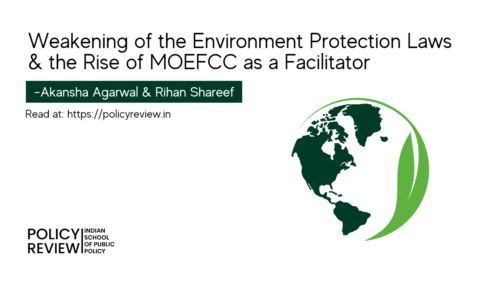
Weakening of the Environmental Protection Laws & the Rise of MOEFCC as a Facilitator

Abstract
This policy analysis reviews the widening gap between India’s global stance on climate change and the recent changes it has brought in its domestic laws and regulations. It briefly analyses the three major changes the government of India has brought out, the amendments in the Wildlife Protection Act, the new Forest Conservation Rules, and the proposed amendment to the Environment Protection Act. It is argued that there is a weakening of regulations in order to favour businesses and development. The piece also observes the ever-growing need to take a determined shift in policy from viewing forests as a resource to be exploited as owners to one of care and conservation through the ‘Public Trust Doctrine’. This requires a conscious effort from breaking from the colonial structures to take a decentralised approach.
Key words
Climate Change, Environment Law and Policy, Forest Conservation, Sustainable Development, Public Trust Doctrine
Introduction
“Even an entire society, a nation, or all simultaneously existing societies taken together, are not owners of the earth. They are simply its possessors, its beneficiaries, and have to bequeath it in an improved state to succeeding generations.”- Karl Marx
The government of India has historically made an attempt to place itself as a leader in the war against climate change. In 1972, the Stockholm Convention, which practically started the environmental movement of the day, Prime Minister Indira Gandhi was the only foreign head of state present. ( Anderson,2022) Prime Minister Narendra Modi has also been regarded as a ‘Champion of Earth’ for his ‘bold environmental leadership in the global stage’. However, the harsh reality is India’s international commitments seem to be inconsistent with the development of domestic laws in the country. The Indian Forest Service and management of forests were taken over by the British after Independence whose relationship was that of ownership and ‘extractivism’ rather than of nurture, care, and sustainable use with proper respect for the local community. (Easton & Gwaindepi, 2021)
The Supreme Court introduced the ‘Public Trust Doctrine’ in India in 1997, which provides that the government is merely a trustee of the environment, not its owner. (MC Mehta vs Kamal Nath). The court advocated striving for general interest over private interest in the environment. Despite this, the government has brought out forward three major changes in environmental jurisprudence in the recent past. Firstly, the proposed amendments to the Indian Forest Act, 1927 which intends to decriminalise offences related to the contravention of rules under the Act. (“Notice for Public Consultation,” 2023). Government on August 4th tabled in the Rajya Sabha, the newly notified Forest Conservation Rules, 2022 altering forest clearance to a more centralised norm and finally passing the Wildlife Amendment Bill, 2021 in Lok Sabha and Rajya Sabha which intended for forest conservation to include the Convention on International Trade in Endangered Species of Wild Fauna and Flora (CITIES) an international agreement for trading in flora and fauna. The Bill now received presidential assent and is an act.
Forest Conservation Rules, 2022
As per the new Forest Conservation Rules as notified by the MoEFCC, Rule 9 and 11 has devised a more simplified method for private parties to start planting trees in order to meet the compensatory afforestation requirements. This simplification of the process, in light of our observations during the first and second lockdowns in 2020 is deeply concerning. During this period 16 projects related to highways, transmission lines and railway lines through national parks, sanctuaries and tiger corridors spanning over 3,000 acres of eco-sensitive park were approved without a site inspection. This process has continued post-pandemic as well, wherein big projects of up to 1,50,000 square metres in protected forest across the country benefiting MNCs and private players were approved. In the case of Lafarge Mining (Lafarge Umiam Mining v. Union of India), the Union Government was requested by the Supreme Court to designate a national regulator for project evaluation, enforce environmental regulations for clearances, and impose fines on violators. With the coming of the new rules, the government has only violated settled law laid down by the Supreme Court, but further weakened it by making the forest clearance process more streamlined and weakening the regulations.
Moreover, the government has also failed to establish the tribal and forest inhabitants’ rights. Previously, according to Rules 2 and 3 of the 2009 Environment Ministry Order, the State government was required to give the Forest Advisory Committee (FAC) a report addressing the rights and claims of forest dwellers. It was further stated that unless the forest rights are settled with the approval of the local body, FAC will not entertain the proposal. However, there are no such powers provided to the Forest Dwellers to reject the proposal in the current rules. Even though Orissa Mining Corp Judgement (Orissa Mining Corporation Ltd v Ministry of Environment and Forest) affirmed the rights of the forest dwellers and tribals, the rules have yet again failed to keep these established rights into consideration. It can be said that the government’s obsession with ‘Ease of doing business’ comes at the cost of ‘Ease of Living’.
The Proposed Amendments to Indian Forest Act, 1927
The government while proposing the amendments to the Indian Forest Act, 1927 has set out the objectives as ‘reducing the compliance burden on citizens’ and ‘preventing harassment of citizens.’ This indicates the priorities at hand for amending the act, are not premised on conservation or protection but on developmental interests. The violations in the reserved forest area were punished by a maximum of six-month imprisonment or/and a fine of 500 rupees, while retaining the fine amount, the imprisonment provision has been removed with mere compensation for the damage. Such removal of criminal punishment with mere compensation for damage would be an insufficient deterrent. The criminal provision of the offences mentioned in Section 33 with regards to violation of the forest rules has completely been removed and merely a 500 rupee fine has been retained as punishment. This is woefully inadequate as the gains from the violation would be significantly higher, further incentivising violations as a cost for surpassing rules.
Wildlife Protection Amendment Act
The Government has further shifted the paradigm by turning the regulatory bodies into facilitatory bodies. The Wildlife Protection Act originally aimed at protecting ecological and environmental security. However, the recent amendment, which is based on the international treaty obligation CITIES, is about regulation in the trade of wild animals and not their protection. The statistics on the CITIES website clearly state the number of recorded transactions that have been made in recent years, and the growing numbers are deeply concerning. What is even more alarming is that the National Board of Wildlife’s (NBWL) standing committee, which is a 47-member committee headed by the Prime Minister, does not have a single ecological or wildlife expert. (2020) The fact that the NBWL has become a “clearing house” for projects, where projects are approved regardless of their impact on wildlife, and that the board’s decisions are guided more by economic, strategic, political, and other considerations than by wildlife conservation is a major concern.(2021)
The government has also launched an online portal for environmental clearances- Parivesh Portal, which is yet another instance of the government being a facilitator rather than a regulator. This portal aims at improving the ease of doing business under the garb of transparency.
Critical Necessity
India despite ranking tenth in the world in terms of forest area, it is 120th in terms of forest cover percentage. The latest State of Forest in India Report (ISFR) published by the Forest Survey of India states that the forest cover across the geographical area of the country is 21.71%. (“India State of Forest Report, 2021,” 2021) The attempt to enhance tree cover by up to 33% falls under the National Mission for a Green India (GIM), one of eight Missions within the National Action Plan on Climate Change (NAPCC), in addition to preceding national forest policy objectives. Given these predictions, India must expand its tree cover by a minimum of 12 percent over the next decade, or by an average of 32,874 square kilometres every year. The changes in the law, rules and proposed amendments do not inspire confidence to meet the challenges provided above.
Conclusion
There is a clear systemic need to change the way the forest is viewed across the country. This involves understanding the importance of local communities in making a positive change rather than the centralised approach taken by the government in recent years. The ideal of ‘Social Forestry’ is worth recalling in this situation. (“Planning Forestry Extension Programme,” 1998) AK Banerjee, a district forest officer began his conservation activities in 1972 which turned the relationship of the villagers with the forest, from that of overgrazing and extracting natural minerals to providing incentives to conserve and provide employment through the same. This success story has found its place in various international platforms as well as the National Forest Policy of 1988. (“National Forest Policy (1998),” 1998) This is the approach the government needs to take as ‘possessors’ and ‘beneficiaries’ of the forest as Karl Marx remarked centuries ago or trustees as advocated by the Supreme Court decades ago. The challenge will however be to overcome the extractive relationship of private corporations with money power and ensure nature and local communities are safeguarded.
References
Anderson.(2022,May22).https://www.downtoearth.org.in/blog/climate-change/india-is-key-to-the-success-of-stockholm-50-as-it-was-in-1972-82900. Down to Earth. Retrieved April 22, 2023,from https://www.downtoearth.org.in/blog/climate-change/india-is-key-to-the-success-of-stockholm-50-as-it-was-in-1972-82900
Easton, A., & Gwaindepi, A. (2021, September). Colonial extractivism and development: The state and private diamond extraction at the British Cape Colony, 1870–1910. The Extractive Industries and Society, 8(3), 100945. https://doi.org/10.1016/j.exis.2021.100945
MC Mehta vs Kamal Nath (1997) 1 SCC 388, Supreme Court, 1997
Notice for Public Consultation. (2023, July 7). In www.moef.gov.in. Ministry of Environment, Forest and Climate Change. Retrieved April 24, 2023, from https://moef.gov.in/wp-content/uploads/2022/07/Notice-for-public-consultation.pdf
Forest Conservation Rules, 2022, F. No. FC- 11/118/2021-FC (2022), https://parivesh.nic.in/writereaddata/FCRule2022Notificationdated28062022.pdf
Lafarge Umiam Mining v. Union of India, [2009] W.P. (C) No. 198, Supreme Court, 2009
Orissa Mining Corporation Ltd v Ministry of Environment and Forest & Others, [2013] 6 S.C.R. 881, Supreme Court, 2013
The Wild Life (Protection) Amendment Act, 2022, Parliament of India, ( 20th December 2022)
What is CITES? | CITES. https://cites.org/eng/disc/what.php
(2020, April 26). India’s National Board for Wildlife Is a Big Threat to India’s Wildlife. Science, the Wire. Retrieved April 24, 2023, from https://science.thewire.in/environment/national-board-for-wildlife-prakash-javadekar-environment-ministry-destruction-protected-areas/
(2021, January 16). National Board for Wildlife and the Illusion of Wildlife Protection. Www.Epw.In,56(3). https://www.epw.in/journal/2021/3/insight/national-board-wildlife-and-illusion-wildlife.html
India State of Forest Report, 2021. (2021). In Forest Survey of India. Forest Survey of India. Retrieved April 24, 2023, from https://fsi.nic.in/forest-report-2021-details
Planning Forestry Extension Programme (1998). In Food and Agricultural Organisation of United Nations (GCP/RAS/l 11/NET Field Document No. 8). Retrieved April 24, 2023.
National Forest Policy (1998). (1998, December 7). In Ministry of Environment and Forest (No. 3-1/86-FP). Ministry of Environment and Forest. Retrieved April 24, 2023, from https://mpforest.gov.in/img/files/Policy_NFP.pdf

Rihan Shareef
Rihan Shareef is a third-year law student. He is a public-policy enthusiast with an interest in areas of gender justice, data governance and environmental law.

Akansha Agarwal
Akansha Agarwal is a third-year law student with an active interest in public policy and in the areas of environmental law, arbitration and gender justice.

